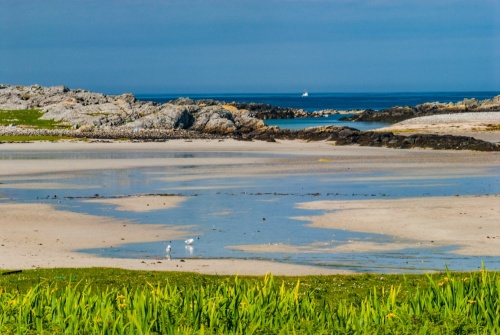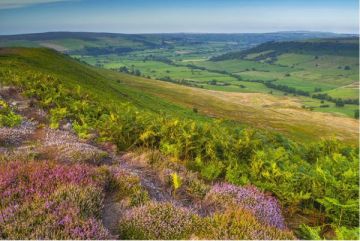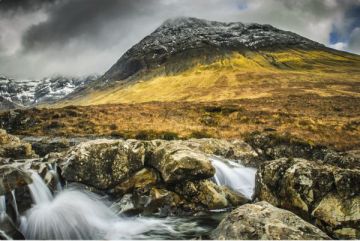
A world apart - the Isle of Colonsay is a jewel of an island in the Inner Hebrides off Scotland's west coast. The island is no more than 8 miles from tip to toe, but in between lies an extraordinary landscape of rock, moorland, and stunning, sandy beaches.
Whether your interests lie in history or simply in relaxing on a secluded beach, Colonsay has something for everyone.
At the southern end of Colonsay is The Strand, a strait that separates Colonsay from the island of Oronsay. The Strand is laid bare at low tide, allowing visitors to walk a magical mile across the sand to Oronsay, where the ruins of a medieval priory stand in a nature reserve famous for its birdlife and resident seal population.

Oronsay Priory
The remains of Oronsay Priory that we see today are those of a 14th-century Augustinian monastery. The medieval buildings are thought to stand on the site of a 6th-century monastery founded by St Oran, for whom the island is named.
In front of the priory ruins stand a carved 15th-century cross, known as the Great Cross, and within one of the old priory buildings is an exhibition of medieval grave slabs recovered from the site. Several of the beautifully carved grave slabs are those of 16th-century chiefs of Clan MacDuffie (Macfie).

History
Colonsay was settled at least as early as the Mesolithic period, about 6.000 BCE, making it one of the earliest Mesolithic settlements in Britain. Investigation near Staosnaig, south of Scalasaig, revealed evidence of large-scale hazelnut shelling and burning, with stone-lined pits and a hearth.
The island boasts a wealth of later Neolithic and Bronze Age sites, including the hill fort of Dun Gallain, and standing stones at Scalasaig, Balnahard, and Garvard. The best-known of all prehistoric sites on Colonsay, however, is the pair of standing stones at Kilchattan, known as Fingal's Limpet Hammers after the mythical Celtic giant Fingal.
At Balerominmore is a standing stone that has been reused to form an early Christian cross. It is known as The Macfie Stone after the last clan chief of the Macfies was tied to the stone and murdered in 1623. The former Macfie fortress of Dun Eibhinn occupies a hilltop west of Scalasaig.

A Holy Well
On the slope of Carnan Eoin, north of Kiloran Bay, is St Columba's Well, an ancient holy well said to have healing qualities. The well is dedicated to, and is said to have been created by, St Columba himself.
If you follow the track north from St Columba's Well, past Balnahard Farm, you come to the ruins of an early Christian chapel known as Cill Chaitriona, said to have been founded by monks from Iona. Near the chapel stands the Clach A'Pheanais, or The Penance Stone, which may have been used for flagellation or other acts of penance by parishioners following confession at the chapel.
The ruins of a 14th-century chapel dedicated to St Catan stand at Lower Kilchattan.
Enough about ruined churches! What about one that is very much still in service? Scalsaig Parish Church was built as a chapel of ease in 1802, to save the islanders from having to make the journey to Islay to worship.

Colonsay escaped the worst of the Clearances that so badly disrupted the traditional crofting life of the Hebrides. The sixth Lord Colonsay, in particular, refused to oust crofting families from the land they had farmed for generations. His fair treatment of the islanders resulted in the Lord Colonsay Monument, a granite pillar erected on a hill overlooking Scalasaig in 1879.
The islanders may not have suffered from the Clearances as much as other Scottish islands, but life wasn't easy for those inhabiting the scattered hamlets of Colonsay. North of Scalasaig stand the roofless ruins of the cottages that once made up the settlement of Riasg Buidhe, known as 'The Fever Village'.
The name is misleading; Riasg Buidhe was not deserted because of fever, rather, the villagers found it impossible to make a living at the herring fishery and eventually left, many of them moving to Glassard.

Clan Associations
Colonsay is the traditional home of Clan Macfie (variations of the clan name include MacDuffie and MacPhee) and a branch of Clan MacNeil. The Macfies were dispersed and their lands seized after the death of the last chief, and they were only reconstituted in the 20th century. Macfies from around the world now make a pilgrimage to Colonsay and The Macfie Stone, a symbol of clan history and resilience.

Beaches
If you enjoy relaxing on a beach of pure white sand, far from the crowds, then Colonsay is for you. The island boasts an extraordinary array of beaches, some small, some large, some remote, and some absurdly easy to reach by car. The most popular beach is at Kiloran Bay, in the north-west corner of the island. Here, the sandy beach is backed by machair and bends in a gentle arc to create a semicircle. Kiloran is popular with surfers.
If you stretch your legs and take the trail north and east from Kiloran Bay you come to the remote east-facing beach at Balnahard Bay. Even on sunny summer days, you are likely to have this beautiful stretch of clean white sand to yourself.
Another popular 'beach' is the sandy causeway that separates Colonsay from Oronsay to the south. When the tide is at its lowest ebb you can walk across the sand to Oronsay and visit the priory. On the eastern side of The Strand is Beinn Eibhne, a low hill. Projecting from the rocky hill is a ledge of rock with a hole worn through it. This is known as Hangman's Rock and was used in the past for public executions.
See our guide to beaches on Colonsay for more suggestions from our travels around the island.

Colonsay House Gardens
A 20-acre rhododendron garden surrounds historic Colonsay House, built in the early 18th century. The garden is a product of the 1930s and consists of a small formal garden near the house and a larger woodland garden stretching away from the property.
Colonsay House Gardens has been called one of the finest gardens in Scotland. The woodland garden is open daily throughout the year, but the formal gardens are only open during the summer months.
In the garden stands a small carved figure known as the Tobar Oran Sculptured Stone, thought to date to the 8th century.
But Colonsay is not all about the past! There are local arts and crafts to enjoy, and the island has its own micro-brewery. There is even a nine-hole golf course near the small airport - though you have some unusual 'hazards' on the course, as sheep wander across the grass.
There is even a piece of art on a vast scale; the Colonsay Whale Sculpture. The sculpture is a huge figure of a whale formed by beach stones laid out on the foreshore at Port Sgibinis, near Balnahard.
I can't recommend Colonsay highly enough - if you fancy getting away from it all, this beautiful Scottish island may be just what you need!

Getting There
Colonsay can be reached by ferry from Oban or Port Askaig. The Oban service runs five days a week, dropping to three days a week in winter. The Port Askaig service runs two days a week. Both ferries are run by Caledonian MacBrayne (CalMac). Ferries arrive at the Scalasaig terminal.
Be aware that there is no public transport on Colonsay, so if you arrive on foot, be prepared to walk to your destination. The good thing is, of course, that the island is so small that walking to your destination can be pure joy!


